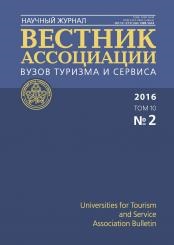Moscow, Russian Federation
This article is another publication of the research results of foreign models of training for the tourism sector. All the author´s publications are based on a single cycle of a conceptual representation of professional education in the field of tourism as an activity-system which has its own goal-setting and invariant and variable structural elements, super-system limiters, resources, and so on. Comparative analysis of foreign models of training for tourism allows identifying the essential characteristics of the basic structure and content of models, which affect the efficiency of education systems, which in turn means the maximum achievement of the purposes of educational activities for their participants. In order to analyze the model of training for the tourism industry in Norway were used the author´s own methods of analyzing the structure and content of vocational education in the field of tourism developed in order to study quantitative and qualitative parameters of education. As sources of information the author uses both secondary (research reports, statistics) and primary (results of surveys and interviews with representatives of education, students; pedagogical documentation) sources. The study of the Norwegian model of training for tourism includes: a research framework of conditions for the establishment and development of a training system for tourism in Norway; a study of tourism employment in Norway, which has a pronounced specificity (seasonality, alternative forms of tourism); a study of the structural features of the formation and continuity of educational levels. Of particular interest are the results of a study of factors affecting the consumer subsystem parameters, in particular, focus on student training; validity of educational levels and modules which direct education at the development of human resources. The results of the study lead to the conclusion about high levels which characterize the consumer subsystem of the system of professional education in the field of tourism. It is also possible to formulate an assumption about a correlation between the indicators of competitiveness of the tourism sector (in terms of the parameters describing human resources) and the indicators characterizing the consumer subsystem of the training system for the tourism sector.
models of training for tourism, comparative pedagogical analysis, structure of education in tourism, content of education in tourism
Охарактеризуем рамочные условия системы подготовки кадров для туризма в Норвегии. Норвегия — небольшая страна, насчитывающая около 5,1 млн жителей. Туристская сфера не является основной по получению доходов в норвежскую экономику, однако туризм в Норвегии хорошо известен во всем мире. Основные виды туристского предложения связаны с природными ресурсами: главными сезонами прибытия туристов являются: летний сезон (май — сентябрь) и зимний сезон (ноябрь — март); межсезонные периоды характеризуются существенным снижением потока.
Выраженная сезонность в туризме обуславливает характер занятости в сфере: в межсезонные периоды предприятия индустрии туризма не нуждаются в большом количестве сотрудников, таким образом, на разных квалификационных уровнях, в основном, на невысоких, в рабочих профессиях, занятость в существенной степени носит временный характер. На периоды высоких сезонов практикуется дополнительный набор работников, в том числе из-за рубежа. Предприятия туризма, ориентированные на летний сезон, расположены на западном и южном побережьях Норвегии.
Компании, ориентированные на летний и зимний сезоны, расположены в горных регионах страны. Наибольшая востребованность в кадрах ощущается в Норвегии в летний и зимний сезоны в крупных городах — «воротах прибытия» туристов: Осло, Бергене, Ставангере, Трондхайме.
1. Sakharchuk E.S. Metodika analiza zarubezhnykh modeley podgotovki kadrov dlya sfery turizma. Vestnik Assotsiatsii vuzov turizma i servisa. 2014. № 3. S. 78-86.
2. Sakharchuk E. S. Analysis of Practice Centered Aspects of Educational Programs in the Sphere of Tourism and Hospitality. World Applied Sciences Journal 27 (Education, Law, Economics, Language and Communication): 305-308, 2013.
3. knoema.ru/WTTC2013/world-travel-and-tourism-council-data-2013 (data obrashcheniya: 10.10.2014).
4. http://www.ssb.no/en/innrapportering (data obrashcheniya: 10.10.2014).
5. http://www.hit.no (data obrashcheniya: 10.10.2014).





